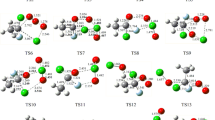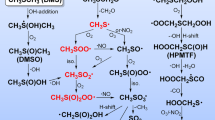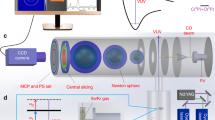Abstract
THE difference in both rate and mode of chemical reaction shown by the first electronically excited state of the group VI elements (that is, … np4(1D2)), relative to that of their ground electronic state (… np4(3PJ)), has been of considerable interest1–4. Furthermore, recent observation of the more highly excited singlet state of the sulphur atom S(… 3p4(1S0)) (S(31S0) – S(31D2 = 1.61 eV; S(31D2) – S(33P2) = 1.15 eV) by kinetic absorption spectroscopy in the vacuum ultraviolet has permitted a comparison of the chemical behaviour of this state with that of the lower states2. The S(31S0) atoms were generated by vacuum ultraviolet flash photolysis of OCS in the presence of a large excess of the inert gas argon (pOCS = 10.6 Nm−2; pAr = 2.66 kNm−2). S(31D2) atoms were not observed in this system, however, despite compelling evidence for their initial production2. No quantitative data have been given for the efficiency of quenching of S(31D2) by the inert gases, although such data are available for the analogous state of oxygen. Some measure of disagreement concerning the absolute rates for quenching of O(21D2) appears to exist, however, and the most recent absolute estimates4,5 imply that quenching occurs with an efficiency of one collision in 200 for argon. If quenching of S(31D2) by argon occurs with a similar efficiency, then one reason for the failure to observe this state in the vacuum ultraviolet photolysis of OCS2 is clear. We have therefore repeated the earlier experiments replacing argon by helium as the inert diluent gas, for helium is known to be particularly inefficient in quenching O(21D2) atoms3–5. The kinetics of the S(31S0) atoms are unaffected by this change, in agreement with the previous conclusions2, but the strong spectrum of S(33PJ) observed in the presence of argon at short delay is virtually absent in the presence of helium. Furthermore, the rapid growth of a strong spectrum of S2(g1Δu←a1Δg) is now seen, whereas in the presence of argon this spectrum was weak2. At longer delays, the S2(a1Δg) state is apparently quenched to yield S2(X3σg−) (Fig. 1). These observations are in agreement with the mechanism proposed by Strausz and Gunning et al.>1,6. 

 In the presence of helium, k2 appears to be negligible; about twenty per cent of the sulphur atoms are observed in the S(33P2) state, which may represent the fraction formed in the primary photochemical process. Thus, provided k3[M]≪k1[OCS], the rate constant for reaction into the quantum state S2(a1Δg) may be obtained by monitoring the growth of the spectrum S2(g1Δu←a1Δg). The magnitude of k3[M] was derived from the decay of S2(a1Δg) at longer times up to 100 µs. A value of k1[OCS] was then obtained by curve fitting the integrated form of the differential equation for the formation of S2(a1Δg), comprising terms due to reactions (1) and (3) and an analytical form for the photoflash output, with the observed intensity variation of the transition S2(g1Δu←a1Δg). It was found that the experimental points gave the best fit for a value of k1 > 4 × 1013 ml. mole−1 s−1 which corresponds to reaction for less than one collision in four. A lower limit for this rate constant has previously been given as 4 × 1011 ml. mole−1 s−1 (ref. 6). Thus the rate constant for the reaction of S(31S0) with OCS is significantly lower; it has been shown by direct observation of this state using kinetic absorption spectroscopy2 to be 6 × 1012 ml. mole−1 s−1.
In the presence of helium, k2 appears to be negligible; about twenty per cent of the sulphur atoms are observed in the S(33P2) state, which may represent the fraction formed in the primary photochemical process. Thus, provided k3[M]≪k1[OCS], the rate constant for reaction into the quantum state S2(a1Δg) may be obtained by monitoring the growth of the spectrum S2(g1Δu←a1Δg). The magnitude of k3[M] was derived from the decay of S2(a1Δg) at longer times up to 100 µs. A value of k1[OCS] was then obtained by curve fitting the integrated form of the differential equation for the formation of S2(a1Δg), comprising terms due to reactions (1) and (3) and an analytical form for the photoflash output, with the observed intensity variation of the transition S2(g1Δu←a1Δg). It was found that the experimental points gave the best fit for a value of k1 > 4 × 1013 ml. mole−1 s−1 which corresponds to reaction for less than one collision in four. A lower limit for this rate constant has previously been given as 4 × 1011 ml. mole−1 s−1 (ref. 6). Thus the rate constant for the reaction of S(31S0) with OCS is significantly lower; it has been shown by direct observation of this state using kinetic absorption spectroscopy2 to be 6 × 1012 ml. mole−1 s−1.
This is a preview of subscription content, access via your institution
Access options
Subscribe to this journal
Receive 51 print issues and online access
$199.00 per year
only $3.90 per issue
Buy this article
- Purchase on Springer Link
- Instant access to full article PDF
Prices may be subject to local taxes which are calculated during checkout
Similar content being viewed by others
References
Strausz, O. P., and Gunning, H. E., Advances in Photochemistry, 4 (Interscience, New York, 1966).
Donovan, R. J., Trans. Faraday Soc., 1969 (in the press).
McGrath, W. D., and McGarvey, J. J., Planet. Space Sci., 15, 427 (1967).
Young, R. A., Black, G., and Slanger, T. G., J. Chem. Phys., 49, 4769 (1968).
Preston, K. F., and Cvetanovic, R. J., J. Chem. Phys., 45, 2888 (1966).
Fowles, P., de Sorgo, M., Yarwood, A. J., Strausz, O. P., and Gunning, H. E., J. Amer. Chem. Soc., 89, 1352 (1967).
Shuler, K. E., J. Chem. Phys., 21, 624 (1953).
Herzberg, G., Molecular Spectra and Molecular Structure III, Electronic Spectra and Electronic Structure of Polyatomic Molecules (Van Nostrand Inc., New York, 1966).
Thrush, B. A., Ann. Rev. Phys. Chem., 19, 371 (1968).
Basco, N., and Pearson, A. E., Trans. Faraday Soc., 63, 2684 (1967).
Author information
Authors and Affiliations
Rights and permissions
About this article
Cite this article
DONOVAN, R., KIRSCH, L. & HUSAIN, D. Rate of the Reaction of S(3p4 ID2) with OCS. Nature 222, 1164–1165 (1969). https://doi.org/10.1038/2221164a0
Received:
Issue Date:
DOI: https://doi.org/10.1038/2221164a0
This article is cited by
-
Kinetics and mechanism of the decomposition of CS2, OCS, and SCl2 in a radiofrequency pulse discharge
Plasma Chemistry and Plasma Processing (1982)
Comments
By submitting a comment you agree to abide by our Terms and Community Guidelines. If you find something abusive or that does not comply with our terms or guidelines please flag it as inappropriate.



